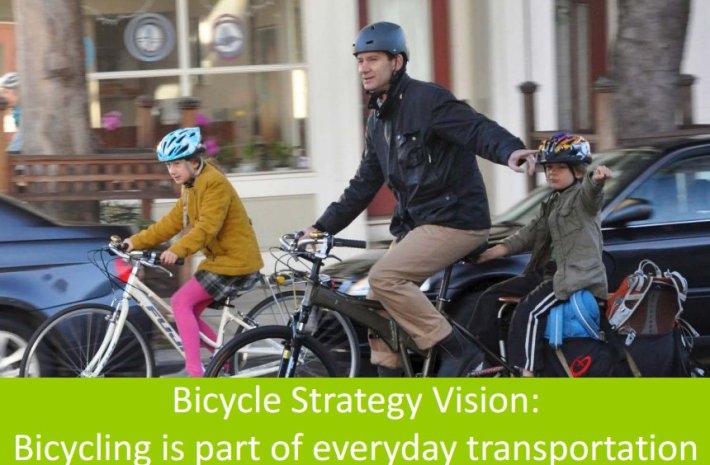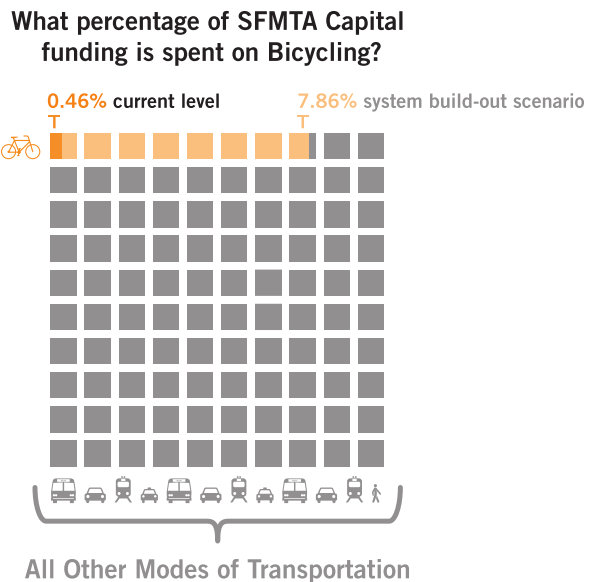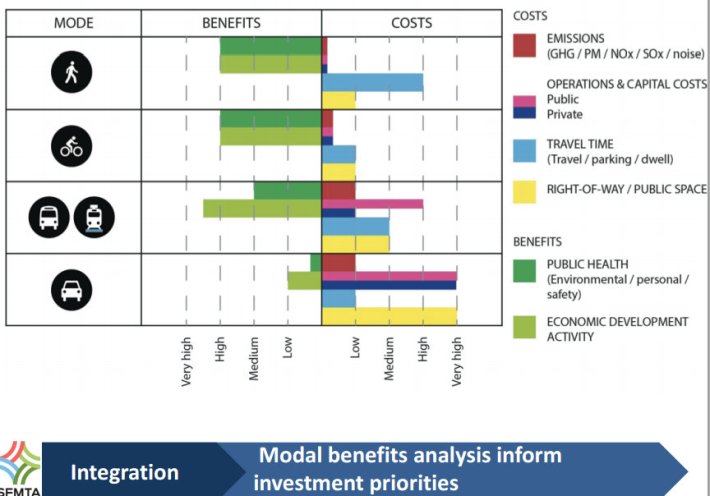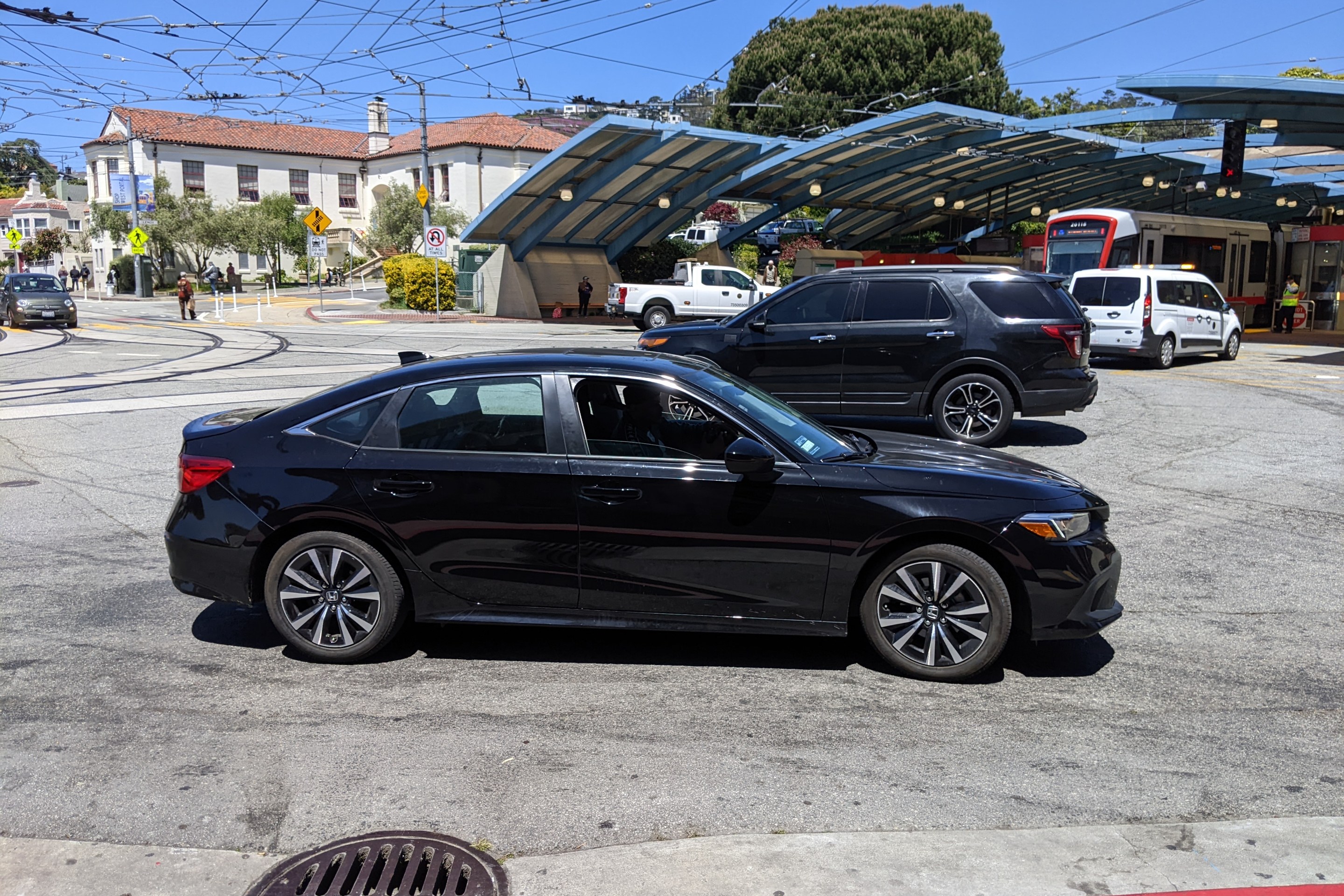SFMTA’s Bicycle Strategy Could Make SF Top in the Nation — If It’s Funded
6:25 PM PST on January 30, 2013
The SF Municipal Transportation Agency has mapped out a course that could make San Francisco the most bike-friendly city in the nation. All it needs now, it seems, is the political leadership to step up and fund what SFMTA Director Ed Reiskin has called the "most cost-effective investment we can make in moving people."
The SFMTA's Draft Bicycle Strategy [PDF], presented to the agency's board yesterday, lays out three rough scenarios for improvements to the city's bicycle infrastructure, based on the amount of funding the city provides. While it doesn't lay out a specific plan for bike improvements, the strategy serves as a compass to guide implementation of a connected network of protected bike lanes, bike boulevards, bike parking, a robust bike-share system, and campaigns to promote bicycling as a regular means of transportation.
To reach the city's official goal of 20 percent of trips by bike by 2020, the SFMTA estimates it would have to implement the most ambitious of its three proposed scenarios, called the "System Build-Out." It calls for the construction of 35 miles of new bicycle facilities, upgrading 200 miles of the existing bike network to "premium bicycle facilities," bike improvements at 200 intersections, 50,000 new bike parking spaces, and a bike-share program with more than 300 stations.
The cost of investment -- an estimated $500 million for infrastructure, plus $14 million annually for other programs -- would require a steep increase in bicycle funding compared to the dismal levels under the status quo. According to the SF Bicycle Coalition, the SFMTA currently only allocates 0.46 percent of its capital spending to bicycling, and under the "System Build-Out" scenario, that number would still be less than 8 percent.
"Even those levels are amazingly reasonable," said SFBC Executive Director Leah Shahum. "Funding has not kept pace with the tremendous growth of bicycling in San Francisco. This doesn't sync up with the city's ambitious and rightful goals to grow bicycling and make it a better transportation option for more people."
"There has been an historic under-funding of bicycling in this city," she added. "I think there's clear political and public interest to increase those levels."
There is significant backing for an aggressive increase in funding for bicycling improvements. In a press release, the SFBC shared statements of support from sf.citi -- the SF Citizens Initiative for Technology and Innovation, a tech industry group -- and SF Building and Construction Trades Council Secretary-Treasurer Michael Theriault, who said he's "convinced that the bicycle should become a common everyday way for San Franciscans and visitors to move around the city, as jobs and housing opportunities grow, and I support a comprehensive strategy to create more and better bicycling options."
Several members of the Board of Supervisors also voiced support for significant increases funding to realize the goals in the Bicycle Strategy. "It is time to step up to commit to becoming a great bicycling city," said Board President David Chiu. "San Francisco has already proven that a large and growing number of people want to bike for transportation. Looking ahead, we need to invest appropriately to support these and far more trips by bike because it is a smart investment in a healthier, greener, more accessible city."
Supervisor Scott Wiener called for "taking bicycling seriously in the SFMTA's own budget."
"Unfortunately, our city has historically underfunded key transportation needs, including transit, bicycling and walking," he said. "It is time to reverse this trend and invest in healthy, sustainable, cost-effective transportation for the long-term."
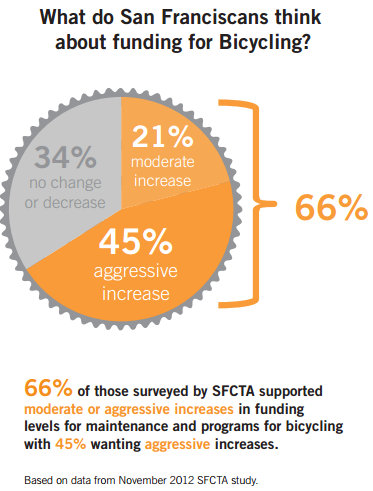
While politicos have been paying lip service to bicycling for the last several years, so far they have taken little action to back it up. The Board of Supervisors adopted the "20 percent by 2020" goal in 2010, but board members like Chiu, the champion of that bill, haven't taken any significant legislative action to help the SFMTA fund the mandate.
Mayor Ed Lee, meanwhile, has yet to follow through on his occasional pro-bike rhetoric, either. In his "State of the City" speech Monday, Lee briefly touted the approaching completion of the projects in the SF Bike Plan, and the repeatedly-delayed launch of bike-share, which is expected this summer, but made no mention of ramping up implementation of bicycle infrastructure in the coming years.
The next few months will be critical for city officials to take the lead and show their commitment to improving bicycling is more than just show. By April, the SFMTA expects to develop its five-year Capital Improvement Plan, where the agency will narrow down the kinds of bicycle improvements it plans to make, and how much funding it will have to build them.
Tim Papandreou, deputy director of transportation planning for the SFMTA's Sustainable Streets Division, told the agency's board of directors that planners are recommending that the agency pursue the "Strategic Plan" scenario, the middle of the Bike Strategy's three options, in which the SFMTA would only build about a quarter of the infrastructure called for in the "System Build-Out." Under that scenario, the agency would spend about $190 million through 2018, and reach an estimated 8-10 percent of trips by bike. "That'd be the highest in North America," said Papandreou.
Also included as an option is the "Bicycle Plan Plus" scenario, the weakest of the three, which would only increase bicycling to an estimated 4.5 percent mode share, from the current 3.5 percent, at a cost of $60 million through 2018.
Unless city leadership takes action to fund the city's commitment to making bicycling an inviting option for more San Franciscans, the agency only expects to have $30 million in available funding for bicycle infrastructure during that time.
"We really need to be putting our money where our mouths are, where our aspirations are," said SFMTA board member Joél Ramos, who noted that enticing more drivers and Muni riders on to bicycles would free up room on congested roads and transit vehicles for those who depend most upon those transport options. "We're going to get to a point where [the city] just can't grow anymore," he said.
Few potential funding sources have been named, but SFMTA officials said the agency could put a general obligation bond on the ballot to fund the bicycle, pedestrian, and transit improvements called for in the agency's broader Strategic Plan, though no dollar amounts have been identified. Revenue could also come from an increase in the vehicle license fee if the Board of Supervisors puts it on the ballot in November, as well as new funding streams once the Transportation Sustainability Program is adopted.
While Reiskin said much of the funds in the agency's capital budget come from grants that can only be used for transit projects, Shahum said the SFMTA could do more to add bike improvements as part of transit and street upgrades. She pointed out that the Federal Transit Administration allows certain amounts of its grants to be used for bike and pedestrian improvements along a transit project's corridor. Pointing to the Central Subway, a $1.6 billion project -- $942 million of which comes from the FTA -- she noted, "Imagine taking a tiny portion of that to improve walking and biking on some of the parallel streets near the planned subway. That would be a huge impact."
"We want the agency to move out of its traditional way of thinking, which is based on silos" of funding for different transportation modes, and thinking "more holistically about moving more people in lots of different ways," said Shahum.
While the ultimate vision for a bike-friendly San Francisco would put it in league with cities like Amsterdam and Copenhagen, where a majority of trips within the city center are taken by bike, SF is already seeing major progress in some of its more bike-friendly neighborhoods, like the Mission and Hayes Valley, where U.S. Census data shows that more than 15 percent of commute trips were by bike as of 2010.
In a statement, D9 Supervisor David Campos said he's "proud" that some of these findings came from neighborhoods he represents. "We are proving it is possible, and that number is only growing as we make it easier and more inviting to bike," he said. "Now is the time for the SFMTA to step up its commitment -- including funding -- to help even more communities become accessible for biking.”
"The proof is already there," said Shahum, "that even small investments are working."
Stay tuned for coverage of the SFMTA's Pedestrian Strategy tomorrow.
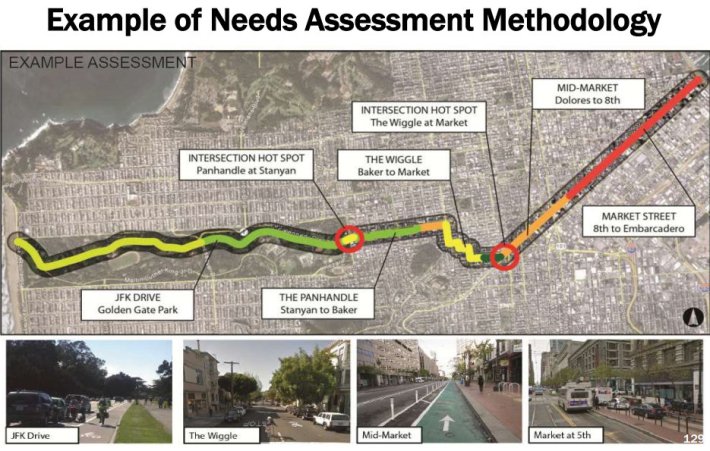
Read More:
Stay in touch
Sign up for our free newsletter
More from Streetsblog San Francisco
Supervisor Melgar Betrays Promises, Sells Out Family Killed in West Portal
Well that didn't take long
